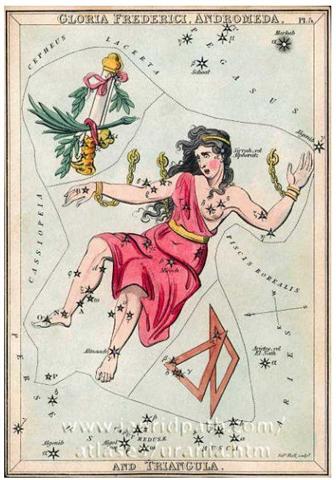1. Searching for a star with a current right ascension corresponding to the position of Rogo in Gb6-26 proved to be an easy task:
Only one star could come in question, viz. Sirrah (α in Andromeda) at 00h 06m:
Another name for this star is Alpheratz: "α And (Alpheratz, Sirrah) is the brightest star in this constellation. It is a binary star with an overall apparent visual magnitude of 2.06m. This star forms an asterism known as the 'Great Square of Pegasus' with three stars in Pegasus: α, β, and γ Peg. As such, the star was formerly considered to belong to both Andromeda and Pegasus, and was co-designated as 'Delta Pegasi (δ Peg)', although this name is no longer formally used." (Wikipedia)
With a right ascension close to zero Sirrah will correspond to autumn equinox south of the equator. In a Moon calendar there is no solstice, and my earlier idea of Rogo in Gb6-26 standing at a solstice cannot be right (or at least not the full truth). The present position in the year is equinox:
With Moon being a character which in every respect is the opposite of Sun there is a kind of logic in letting equinox be a position of immobility for Moon (when Sun moves at his quickest). Equinox is where summer changes to winter (or the other way around on the other side of the equator). There is a great season before and another great season behind (it is a place for Janus). Probably Andromeda represents one of these 'years' and Pegasus the other. North of the equator Andromeda should be the old 'year' and Pegasus the new 'year'. Andromeda is a woman and she must correspond to Moon, while Pegasus then must be the representative of Sun. South of the equator it should be the same - the prime season of Moon comes first and then, on her back side, comes a reflection of the season of Sun (on the other side of the equator). The Rogo glyph type has no legs, maybe to allude to the old woman in the corner (she who never moves): ... The Raven stole the skin and form of the newborn child. Then he began to cry for solid food, but he was offered only mother's milk. That night, he passed through the town stealing an eye from each inhabitant. Back in his foster parents' house, he roasted the eyes in the coals and ate them, laughing. Then he returned to his cradle, full and warm. He had not seen the old woman watching him from the corner - the one who never slept and who never moved because she was stone from the waist down. Next morning, amid the wailing that engulfed the town, she told what she had seen. The one-eyed people of the sky dressed in their dancing clothes, paddled the child out to mid-heaven in their canoe and pitched him over the side ... Stars are like eyes in the night sky, but they do not come in pairs like ordinary eyes. The puzzling unnatural immobility of the Moon queen probably was in order to reflect - in an opposite manner - the very quick Sun king. In mythology chains were needed to immobilize her: "Andromeda, the Woman Chained ... represents in the sky the daughter of Cepheus and Cassiopeia, king and queen of Aethiopia, chained in exposure to the sea monster as punishment of her mother's boast of beauty superior to that of the Nereids ..." (Richard Hinckley Allen, Star Names. Their Lore and Meaning.)
|
||||||||||||||||||||||||||||||||||||||||||||||||||||||||||||||||||||||




